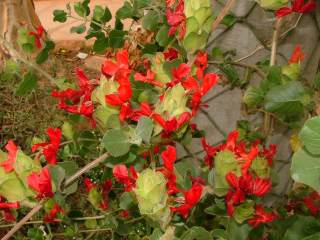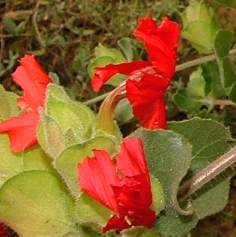Petalidium bracteatum
Petalidium bracteatum Oberm.
Family: Acanthaceae
Common names: Ruacana petalidium (Eng.); Ruacana rooibekkiebos (Afr.)
Introduction
The Ruacana petalidium is a fast and easily growing shrub with striking dark red tubular flowers which attract sunbirds. As its name implies, it originates from northern Namibia and is especially common along the road margin near Ruacana Falls. This shrub is the ideal water-wise subject for dry subtropical gardens, it is easily grown from cuttings and takes well to pruning and other general garden disturbances. It is also related to the Kaokoveld petalidium, P. coccineum.

Description
Description
Erect, fast-growing, moderately branched and slightly aromatic shrub up to 2 m tall and becoming woody with age. Its branches are quadrangular at first are grey, with smooth bark, the younger branches beset with glandular hairs. Its leaves are spreading, and carried in opposite pairs (decussate), are broadly egg-shaped and typically heart-shaped at the base. The leaves can grow to 50 mm long and about the same diameter, on petioles up to 10 mm long, The flowers are carried in characteristic, short, compact axilliary racemes up to 40 mm long.

It flowers for most of the summer months but more so during late summer and autumn. The young buds (4-12-flowered) are protected by layers of large, persistent (imbricate) bracts. The 5-lobed, tubular flowers are characteristically curved; the tube is about 25 mm long; the lobes are dark red; the stamens are fused to the throat of the flower but free at the ends and just protruding. The fruit is a hygroscopic capsule and the seeds are released explosively during a shower of rain.
Distribution and habitat
Distribution description
North to central Namibia from above the western escarpment to Etosha in the east, occurring in dry savanna (bushveld). It is very probable that the plant also occurs in southern Angola. It grows as a pioneer on disturbed soil especially along the road margin. It is associated with other companion species such as mopane (Colophospermum mopane), large-leaved star chestnut (Sterculia quinqueloba), marula (Sclerocarya birrea), blue-leaved commiphora (Commiphora glaucescens), purple-pod terminalia (Terminalia prunioides), hairy-leaved rock fig (Ficus glumosa) and the Namaqua fig (Ficus cordata). Taking its natural habitat into consideration it is best grown in dry, warm and frost-free areas. Where frost is not too severe, the plants should resprout after damage.
Derivation of name and historical aspects
History
According to Jackson (1990), the name Petalidium is derived from the Greek petalon, which is a leaf or petal and probably pertaining to its leaf-like bracts. The species name bracteatum refers to the large overlapping bracts arranged like tiles on a roof (imbricate). It was named by the late Mrs Amelia Obermeyer, botanist at the former Botanical Research Institute in Pretoria in 1959. According to Germishuizen & Meyer (2003), Petalidium bracteatum is one of 29 Petalidium species which have been recorded for southern Africa. Most are confined to the northern, dry, subtropical savanna regions. They belong to the large acanthus family (Acanthaceae), many species of which occur in South Africa.
Ecology
Ecology
Large, tubular, bright-flowering plants rich in nectar are usually an adaptation to attract sunbirds. The Ruacana petalidium provides the bird with sweet nectar (energy) and in return, pollen is rubbed off on to the birds beak or forehead while feeding and transferred to the ripe stigma (receptive female part) of another plant. Plants in our Botanical Society Conservatory are occasionally pollinated by visiting double-collared sunbirds. The seeds ripen during autumn and winter and are released explosively during spring rains in October or November. The slight aromatic nature of the plant is a chemical defence and it is relatively free from insects. The slightly leathery leaves aid in water conservation.
Growing Petalidium bracteatum
Grow
The Ruacana petalidium is best planted in a sunny, well-drained position in a subtropical, frost-free gardens. It also thrives in containers and can be grown in greenhouses. The plants featured here are grown in the Botanical Society conservatory, together with the Kaoko petalidium, in large containers and the plants are trained to cover the netted pillars. The two related species are easily distinguished by the large overlapping bracts of the Ruacana petalidium which are lacking in the Kaoko petalidium. The plants are grown in areas which receive some sunlight, but also have shady corners and they thrive and are very floriferous. Pruning can be done throughout the summer should it be necessary to keep it compact and neat, but the best time is in winter when the plant is in its resting season. The Ruacana petalidium was first cultivated in Pretoria in 1955 from plants collected by Dr Bernard De Winter on an expedition to Ovamboland during November 1955. His plants were collected east of Etosha Pan. The plant was illustrated by Cythna Letty (Obermeyer 1959). Mrs Obermeyer reported that the plant was cultivated at the Botanical Research Institute Garden at Pretoria where it grew rapidly into a lax shrub about 2 m tall, and in spite of the severe frost experienced in 1957, the plant resprouted from its base, again reaching a height of 6 feet after only 9 months.
References
- Germishuizen, G. & Meyer, N.L. (eds). 2003. Plants of southern Africa: an annotated checklist. Strelitzia 14.
- Jackson, W.P.U. 1990. Origins and meanings of names of southern African plant genera. Ecolab, Botany Department, University of Cape Town.
- Obermeyer, A. 1959. Petalidium bracteatum. The Flowering Plants of Africa 33: t. 1317.
Credits
Ernst van Jaarsveld
Kirstenbosch National Botanical Garden
March 2004
Plant Attributes:
Plant Type: Scrambler, Shrub
SA Distribution:
Soil type: Loam
Flowering season: Early Summer, Late Summer, Autumn, Winter
PH: Alkaline, Neutral
Flower colour: Red
Aspect: Full Sun, Shade, Morning Sun (Semi Shade)
Gardening skill: Easy
Special Features:
Horticultural zones








Rate this article
Article well written and informative
Rate this plant
Is this an interesting plant?
Login to add your Comment
Back to topNot registered yet? Click here to register.